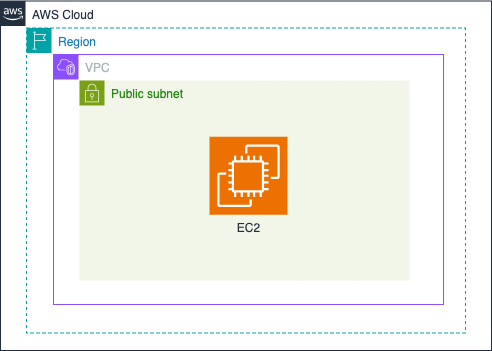AWS 101
使用說明
建置架構

目錄結構
learn-terraform-aws-instance
├── main.tf
組態檔內容
main.tf
terraform {
required_providers {
aws = {
source = "hashicorp/aws"
version = "~> 4.16"
}
}
required_version = ">= 1.2.0"
}
provider "aws" {
region = "us-west-2"
}
resource "aws_instance" "app_server" {
ami = "ami-830c94e3"
instance_type = "t2.micro"
tags = {
Name = "ExampleAppServerInstance"
}
}
Terraform 指令
- mkdir learn-terraform-aws-instance
- cd learn-terraform-aws-instance
- touch main.tf
terraform init
Initializing the backend...
Initializing provider plugins...
- Finding hashicorp/aws versions matching "~> 4.16"...
- Installing hashicorp/aws v4.67.0...
- Installed hashicorp/aws v4.67.0 (signed by HashiCorp)
Terraform has created a lock file .terraform.lock.hcl to record the provider
selections it made above. Include this file in your version control repository
so that Terraform can guarantee to make the same selections by default when
you run "terraform init" in the future.
Terraform has been successfully initialized!
You may now begin working with Terraform. Try running "terraform plan" to see
any changes that are required for your infrastructure. All Terraform commands
should now work.
If you ever set or change modules or backend configuration for Terraform,
rerun this command to reinitialize your working directory. If you forget, other
commands will detect it and remind you to do so if necessary.
- terraform fmt
terraform validate
Success! The configuration is valid.
terraform apply
Terraform used the selected providers to generate the following execution plan.
Resource actions are indicated with the following symbols:
+ create
Terraform will perform the following actions:
# aws_instance.app_server will be created
+ resource "aws_instance" "app_server" {
+ ami = "ami-830c94e3"
+ arn = (known after apply)
+ associate_public_ip_address = (known after apply)
+ availability_zone = (known after apply)
+ cpu_core_count = (known after apply)
+ cpu_threads_per_core = (known after apply)
+ disable_api_stop = (known after apply)
+ disable_api_termination = (known after apply)
+ ebs_optimized = (known after apply)
+ get_password_data = false
+ host_id = (known after apply)
+ host_resource_group_arn = (known after apply)
+ iam_instance_profile = (known after apply)
+ id = (known after apply)
+ instance_initiated_shutdown_behavior = (known after apply)
+ instance_state = (known after apply)
+ instance_type = "t2.micro"
+ ipv6_address_count = (known after apply)
+ ipv6_addresses = (known after apply)
+ key_name = (known after apply)
+ monitoring = (known after apply)
+ outpost_arn = (known after apply)
+ password_data = (known after apply)
+ placement_group = (known after apply)
+ placement_partition_number = (known after apply)
+ primary_network_interface_id = (known after apply)
+ private_dns = (known after apply)
+ private_ip = (known after apply)
+ public_dns = (known after apply)
+ public_ip = (known after apply)
+ secondary_private_ips = (known after apply)
+ security_groups = (known after apply)
+ source_dest_check = true
+ subnet_id = (known after apply)
+ tags = {
+ "Name" = "ExampleAppServerInstance"
}
+ tags_all = {
+ "Name" = "ExampleAppServerInstance"
}
+ tenancy = (known after apply)
+ user_data = (known after apply)
+ user_data_base64 = (known after apply)
+ user_data_replace_on_change = false
+ vpc_security_group_ids = (known after apply)
}
Plan: 1 to add, 0 to change, 0 to destroy.
Do you want to perform these actions?
Terraform will perform the actions described above.
Only 'yes' will be accepted to approve.
Enter a value: yes
aws_instance.app_server: Creating...
aws_instance.app_server: Still creating... [10s elapsed]
aws_instance.app_server: Still creating... [20s elapsed]
aws_instance.app_server: Still creating... [30s elapsed]
aws_instance.app_server: Still creating... [40s elapsed]
aws_instance.app_server: Still creating... [50s elapsed]
aws_instance.app_server: Creation complete after 59s [id=i-0f7ad50f87bb835da]
Apply complete! Resources: 1 added, 0 changed, 0 destroyed.
terraform show
# aws_instance.app_server:
resource "aws_instance" "app_server" {
ami = "ami-830c94e3"
arn = "arn:aws:ec2:us-west-2:304317510309:instance/i-0f7ad50f87bb835da"
associate_public_ip_address = true
availability_zone = "us-west-2a"
cpu_core_count = 1
cpu_threads_per_core = 1
disable_api_stop = false
disable_api_termination = false
ebs_optimized = false
get_password_data = false
hibernation = false
id = "i-0f7ad50f87bb835da"
instance_initiated_shutdown_behavior = "stop"
instance_state = "running"
instance_type = "t2.micro"
ipv6_address_count = 0
ipv6_addresses = []
monitoring = false
placement_partition_number = 0
primary_network_interface_id = "eni-0d5ba91e5f6cf9abd"
private_dns = "ip-172-31-29-171.us-west-2.compute.internal"
private_ip = "172.31.29.171"
public_dns = "ec2-35-93-46-122.us-west-2.compute.amazonaws.com"
public_ip = "35.93.46.122"
secondary_private_ips = []
security_groups = [
"default",
]
source_dest_check = true
subnet_id = "subnet-043334b68a0e6f560"
tags = {
"Name" = "ExampleAppServerInstance"
}
tags_all = {
"Name" = "ExampleAppServerInstance"
}
tenancy = "default"
user_data_replace_on_change = false
vpc_security_group_ids = [
"sg-0c81eb3bf82ed02e0",
]
capacity_reservation_specification {
capacity_reservation_preference = "open"
}
cpu_options {
core_count = 1
threads_per_core = 1
}
credit_specification {
cpu_credits = "standard"
}
enclave_options {
enabled = false
}
maintenance_options {
auto_recovery = "default"
}
metadata_options {
http_endpoint = "enabled"
http_put_response_hop_limit = 1
http_tokens = "optional"
instance_metadata_tags = "disabled"
}
private_dns_name_options {
enable_resource_name_dns_a_record = false
enable_resource_name_dns_aaaa_record = false
hostname_type = "ip-name"
}
root_block_device {
delete_on_termination = true
device_name = "/dev/sda1"
encrypted = false
iops = 0
tags = {}
throughput = 0
volume_id = "vol-001f1320cc952313d"
volume_size = 8
volume_type = "standard"
}
}
terraform state list
aws_instance.app_server
- terraform destroy